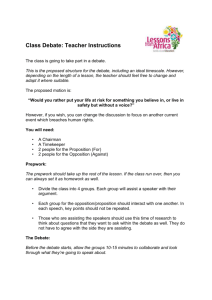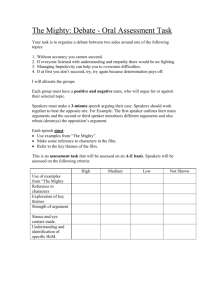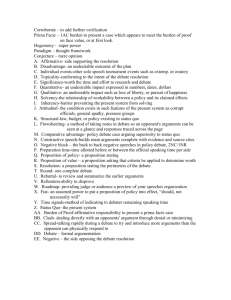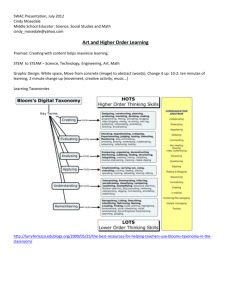Debate Formats - English-Speaking Union Scotland
advertisement
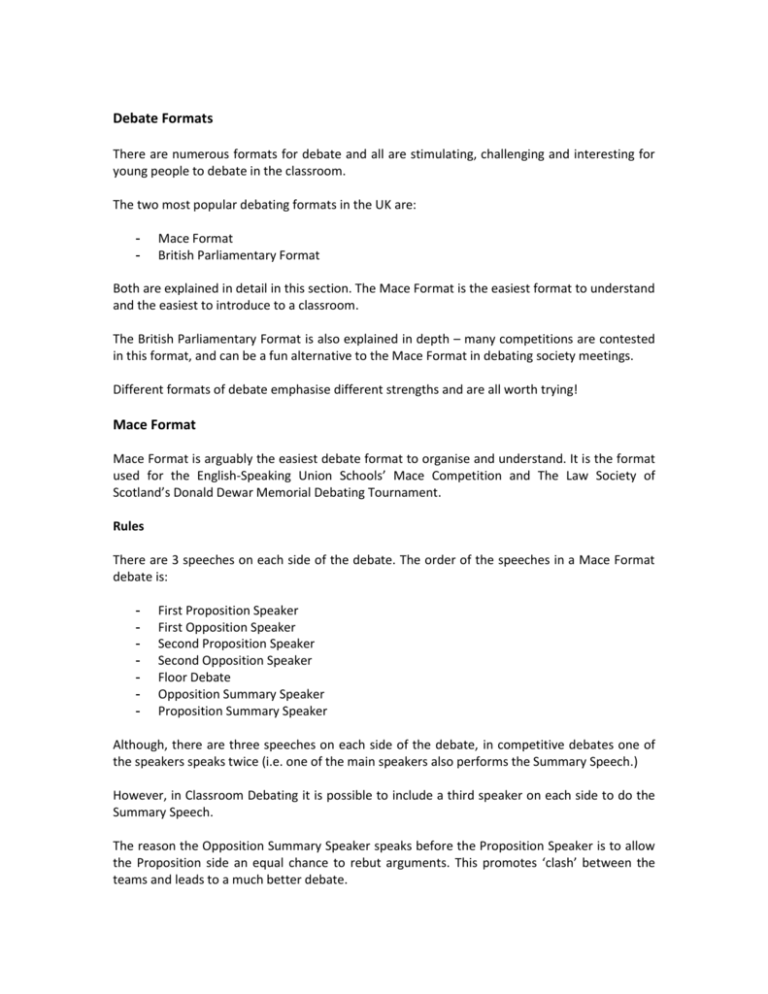
Debate Formats There are numerous formats for debate and all are stimulating, challenging and interesting for young people to debate in the classroom. The two most popular debating formats in the UK are: - Mace Format British Parliamentary Format Both are explained in detail in this section. The Mace Format is the easiest format to understand and the easiest to introduce to a classroom. The British Parliamentary Format is also explained in depth – many competitions are contested in this format, and can be a fun alternative to the Mace Format in debating society meetings. Different formats of debate emphasise different strengths and are all worth trying! Mace Format Mace Format is arguably the easiest debate format to organise and understand. It is the format used for the English-Speaking Union Schools’ Mace Competition and The Law Society of Scotland’s Donald Dewar Memorial Debating Tournament. Rules There are 3 speeches on each side of the debate. The order of the speeches in a Mace Format debate is: - First Proposition Speaker First Opposition Speaker Second Proposition Speaker Second Opposition Speaker Floor Debate Opposition Summary Speaker Proposition Summary Speaker Although, there are three speeches on each side of the debate, in competitive debates one of the speakers speaks twice (i.e. one of the main speakers also performs the Summary Speech.) However, in Classroom Debating it is possible to include a third speaker on each side to do the Summary Speech. The reason the Opposition Summary Speaker speaks before the Proposition Speaker is to allow the Proposition side an equal chance to rebut arguments. This promotes ‘clash’ between the teams and leads to a much better debate. The Floor Debate can last anywhere between 2 minutes and 10 minutes. The Summary Speakers should write their speeches during the Floor Debate. If there are few contributions from the Floor, the Chairperson should give the Summary Speakers a few minutes to write their speeches (Summary speeches cannot be prepared in advance and have to be written during the debate). Speakers are encouraged to offer and accept Points of Information during the main speeches but Points of Information are not allowed during the Summary Speeches. Speech Length The length of speeches in a Mace Format Debate can be adjusted to fit the experience of the debaters in question or to fit the time available for the debate. Whatever the length of the speeches, some rules always apply. The four main substantive speeches (First Proposition, First Opposition, Second Proposition, Second Opposition) should have a set amount of time at the beginning and end ‘protected’ from Points of Information. The start and end of unprotected time (i.e. the time when Points of Information can be offered) should be signalled by a knock on the table or ring of a bell by the timekeeper. For example, if the main substantive speeches are 3 minutes long, the first 30 seconds and the last 30 seconds of the speech should be protected from Points of Information. A double knock on the table is given by the timekeeper at the end of the allotted time (in this example, 3 minutes). This is repeated if the debater is still speaking after a further 15 seconds. After 30 extra seconds, the timekeeper should signal repeatedly and the Chairperson may ask the speaker to conclude his or her speech. If the main substantive speeches are 3 minutes long, the Summary Speeches should be 2 minutes long. During the Summary Speeches no Points of Information may be offered, but a signal is still given 30 seconds from the end of the speech to indicate to the debater that they should begin to close their remarks. The table below provides a rough guide to suitable speech lengths: Suitable For Years Main Speech P7-S1 S1-S3 S3-S5 S4-S6 2 minutes 3 minutes 5 minutes 7 minutes Protected time at each end 30 seconds 30 seconds 1 minute 1 minute Summary Speech 1 minute 30 seconds 2 minutes 3 minutes 4 minutes This is a rough guide as to a degree it is dependent on experience. Many S1-S3 pupils will be able to speak for 5 minutes. Role in the Debate: Each team and each person has a specific role in the debate. Chairperson(s) – The Chair welcomes the audience, briefly introduces the motion (the topic the speakers are going to debate about) and introduces the speakers. Timekeeper(s) – The Timekeeper’s role is to time each speech, signalling the start and end of unprotected time and to note down the amount of time each speaker spoke for. The Proposition Team – The proposition team has the job of persuading the audience why the motion being debated should be supported. The Opposition Team – The Opposition team has the job of persuading the audience why the motion being debated should not be supported by critiquing the arguments put forward by the proposition. The Audience - The audience’s role in a standard Mace Format debate is to take part in the Floor Debate. For Classroom Debating, there are a number of ways to get the audience involved in other ways. British Parliamentary Format British Parliamentary Debate is the most common form of competitive debate in the UK. It is used for the ESU Juniors’ Competition and for most University Union Schools Competitions. It is slightly more nuanced than Mace Style and is a good challenge for more experienced debaters. There are four teams in the debate – two on the proposition side, two on the opposition side. Occasionally there will be six teams in a debate, three on each side. Rules Each of these teams is comprised of two speakers and each team has a very distinct role on the table. The four teams are labelled - First Proposition (Comprising the First Proposition Speaker and Second Proposition Speaker) First Opposition (Comprising the First Opposition Speaker and Second Opposition Speaker) Second Proposition (Comprising the Third Proposition Speaker and Fourth Proposition Speaker) Second Opposition (Comprising the Third Opposition Speaker and Fourth Opposition Speaker) There are 4 speeches on each side of the debate. The order of the speeches in a British Parliamentary is: - First Proposition Speaker First Opposition Speaker Second Proposition Speaker Second Opposition Speaker Third Proposition Speaker Third Opposition Speaker Fourth Proposition Speaker Fourth Opposition Speaker Speech Length Like a Mace Format Debate, the length of speeches in a British Parliamentary Debate can be adjusted to fit the experience of the debaters in question or to fit the time available for the debate. Whatever the length of the speeches, some rules always apply. All 8 speeches should have a set amount of time at the beginning and end ‘protected’ from Points of Information. The start and end of unprotected time should be signalled by a knock on the table or ring of a bell by the timekeeper. For example, if the main substantive speeches are 3 minutes long, the first 30 seconds and the last 30 seconds of the speech should be protected from Points of Information. A double knock on the table is given by the timekeeper at the end of the allotted time (in this example, 3 minutes). This is repeated if the debater is still speaking after a further 15 seconds. After 30 extra seconds, the timekeeper should signal repeatedly and the Chairperson may ask the speaker to conclude his or her speech. The table below provides a rough guide to suitable speech lengths: Suitable For Years S1-S3 S3-S5 S4-S6 Main Speech 3 minutes 5 minutes 7 minutes Protected time at each end 30 seconds 1 minute 1 minute This is a rough guide as many S1-S3 speakers will be able to speak for longer (for example, speech lengths in the ESU Juniors competition are 5 minutes) but pupils new to debating will cope better with shorter speeches. Role in the Debate: Each team and each person has a specific role in the debate. Chairperson(s) – The Chair welcomes the audience, briefly introduces the motion (the topic the speakers are going to debate about) and introduces the speakers. Timekeeper(s) – The Timekeeper’s role is to time each speech, signalling the start and end of unprotected time and to note down the amount of time each speaker spoke for. Audience - The audience’s role in a standard British Parliamentary debate is to take part in the Floor Debate. Explanation of Team Roles in a British Parliamentary Debate Each team has a defined role on the table. British Parliamentary Debate is somewhat nuanced because, in Competitive Debates, not only are the First Proposition team competing against the two opposition teams but they are also competing against the Second Proposition team. That isn’t to say that the teams on the same side are directly arguing against each other or offering points (both of these are against the rules) but means that teams have to think strategically about their role on the table. First Proposition – The First Proposition team should define the motion (tell the audience and judges what the debate is about) and put forward a number of arguments why the motion should stand. The arguments should be divided equally between the two speakers. The second Proposition speaker should include some rebuttal in their speech. First Opposition – The First Opposition team should challenge the arguments put forward by the proposition and present their own arguments telling the audience and judges why the motion should fall. Arguments should be divided equally between the two speakers. Both First Opposition speakers should rebut arguments put forward by the First Proposition speakers. Both of these teams should keep involved in the debate by asking Points of Information to their opponents further down the debate. Second Proposition – The Second Proposition team should introduce an ‘extension’. This simply means material that is new to the debate. The new material should not contradict anything that the First Proposition team have said but should back up and extend upon their points. They should also rebut some of the arguments put forward by First Opposition. Second Opposition – The Second Opposition team should respond to the extension and arguments put forward by the Second Proposition team. They should not contradict anything that First Opposition team have said. All speakers, except the First Proposition speaker, should attempt rebuttal and all are encouraged to offer Points of Information to all speakers on the opposite side of the debate.
